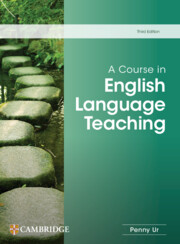Book contents
- Frontmatter
- Contents
- Acknowledgements
- Introduction
- 1 Teaching English today
- 2 The lesson
- 3 Classroom interaction
- 4 Tasks
- 5 Texts
- 6 Teaching vocabulary
- 7 Teaching grammar
- 8 Teaching listening
- 9 Teaching speaking
- 10 Teaching reading
- 11 Teaching writing
- 12 Feedback and error correction
- 13 Assessment and testing
- 14 The syllabus
- 15 Teaching/learning materials
- 16 Teaching content
- 17 Classroom discipline
- 18 Digital technology and online teaching
- 19 Learner differences 1: age
- 20 Learner differences 2: diversity and inclusion
- 21 Teacher development
- Glossary
- References
- Index
- Frontmatter
- Contents
- Acknowledgements
- Introduction
- 1 Teaching English today
- 2 The lesson
- 3 Classroom interaction
- 4 Tasks
- 5 Texts
- 6 Teaching vocabulary
- 7 Teaching grammar
- 8 Teaching listening
- 9 Teaching speaking
- 10 Teaching reading
- 11 Teaching writing
- 12 Feedback and error correction
- 13 Assessment and testing
- 14 The syllabus
- 15 Teaching/learning materials
- 16 Teaching content
- 17 Classroom discipline
- 18 Digital technology and online teaching
- 19 Learner differences 1: age
- 20 Learner differences 2: diversity and inclusion
- 21 Teacher development
- Glossary
- References
- Index
Summary
Teacher-led interaction
Most classroom interaction is teacher-led (see 2 The lesson). And of all the types of teacher-led interaction, the most common is questioning, which has the aim of eliciting responses from students.
Questioning with individual oral responses
Questioning usually takes place within the IRF (Initiation–Response–Feedback) pattern: the teacher initiates the interaction through a question; a nominated student responds; the teacher gives feedback, in the form of confirmation and approval, correction, or rejection.
Teacher: What's the past simple of give?
Student: Gave.
Teacher: Good.
Note that the question may not be a grammatical interrogative: it may, for example, be an imperative (e.g., ‘Tell me …’) or just a declarative sentence (e.g., ‘You’re going to describe …’). The point is that it has the goal of eliciting response(s) from the students.
Pause for thought
What purpose do teacher questions serve in the classroom? Try to think of as many as you can, and then compare your list with the one on the next page. Was there anything you had forgotten? Is there anything you can add?
Comment
Purposes of teacher questions
• To provide a model for language or thinking
• To find out something from the students (e.g., facts, ideas, opinions)
• To check or test understanding, knowledge or skill
• To get students to be active in their learning
• To direct attention or provide a warm-up to the topic which is about to be studied
• To inform the class through students’ answers rather than through the teacher's input
• To provide weaker students with an opportunity to participate
• To stimulate thinking (logical, critical or imaginative)
• To probe more deeply into issues
• To get students to relate personally to an issue
• To get students to review and practise previously taught material
• To encourage self-expression
• To communicate to students that the teacher is genuinely interested in what they think
Any specific question is likely to involve more than one of these; for example, it might review and practise while simultaneously encouraging self-expression.
Types of questions
We can classify teacher questions according to various criteria:
Communicative authenticity. Are they genuine or display questions? Does the teacher really want to find out the answer, or are they simply checking if the student knows it? An example of a genuine question might be: ‘What do you enjoy doing in your free time?
- Type
- Chapter
- Information
- A Course in English Language Teaching , pp. 27 - 40Publisher: Cambridge University PressPrint publication year: 2024

